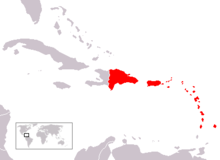
Back የ1773 ዓ.ም. ታላቅ አውሎ ነፋስ Amharic الإعصار الكبير سنة 1780 Arabic Gran Furacán de 1780 AST Ouragan bras 1780 Breton Gran huracà de 1780 Catalan Velký hurikán Czech Store orkan 1780 Danish Großer Hurrikan von 1780 German Gran huracán de 1780 Spanish 1780ko Urakan Handia Basque
 Areas affected by the hurricane (excluding Bermuda) | |
| Meteorological history | |
|---|---|
| Formed | October 9, 1780 |
| Dissipated | October 20, 1780 |
| Unknown-strength storm | |
| 1-minute sustained (SSHWS/NWS) | |
| Highest gusts | 200 mph (325 km/h) |
| Overall effects | |
| Fatalities | est. 22,000 (Deadliest Atlantic hurricane on record) |
| Areas affected | Lesser Antilles, Puerto Rico, Hispaniola, Bermuda, possibly East Florida and some U.S. states |
| [1] | |
Part of the 1780 Atlantic hurricane season | |
The Great Hurricane of 1780[2][1][3] was the deadliest Atlantic hurricane on record, as well as the deadliest tropical cyclone in the Western Hemisphere. An estimated 22,000 people died throughout the Lesser Antilles when the storm passed through the islands from October 10 to October 16.[4] Specifics on the hurricane's track and strength are unknown, as the official Atlantic hurricane database only goes back to 1851.[5]
The hurricane struck Barbados likely as a Category 5 hurricane, with at least one estimate of wind gusts as high as 200 mph (320 km/h),[6] before moving past Martinique, Saint Lucia, and Sint Eustatius, and causing thousands of deaths on those islands. Coming in the midst of the American Revolution, the storm caused heavy losses to the British fleet contesting for control of the area, largely weakening British control over the Atlantic. The hurricane later passed near Puerto Rico and over the eastern portion of Hispaniola, causing heavy damage near the coastlines. It ultimately turned to the northeast and was last observed on October 20 southeast of Atlantic Canada.
The death toll from the Great Hurricane alone exceeds that of many entire decades of Atlantic hurricanes. Estimates are significantly higher than for Hurricane Mitch, the second-deadliest Atlantic storm, for which figures are likely more precise. The hurricane was part of the disastrous 1780 Atlantic hurricane season, with two other deadly storms occurring in October.[4]
- ^ a b Mújica-Baker, Frank. Huracanes y tormentas que han afectado a Puerto Rico (PDF). Estado Libre Asociado de Puerto Rico, Agencia Estatal para el Manejo de Emergencias y Administración de Desastres. pp. 4, 7–10, 12–14. Retrieved October 12, 2018.
- ^ also known as Huracán San Calixto, the Great Hurricane of the Antilles, the Great Hurricane of the West Indies, and the 1780 Disaster
- ^ Orlando Pérez (1970). "Notes on the Tropical Cyclones of Puerto Rico" (PDF). San Juan, Puerto Rico National Weather Service. Retrieved February 12, 2007.
- ^ a b Edward N. Rappaport; Jose Fernandez-Partagas; Jack Beven (1997). "The Deadliest Atlantic Tropical Cyclones, 1492–1996". National Oceanic and Atmospheric Administration. Retrieved January 2, 2007.
- ^ Hurricane Research Division (2006). "Re-Analysis Project". National Oceanic and Atmospheric Administration. Retrieved April 30, 2007.
- ^ Withington, John (2016). Storm: Nature and Culture. Islington, England.: Reaktion Books. ISBN 978-1780237084.
© MMXXIII Rich X Search. We shall prevail. All rights reserved. Rich X Search